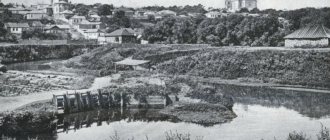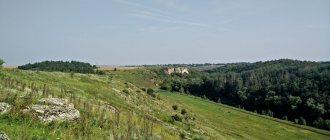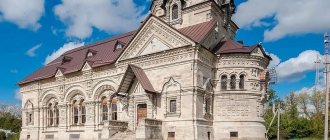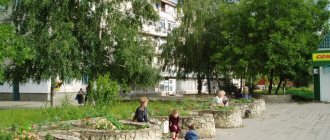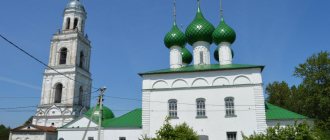Yelets is a city that is liked by connoisseurs of Russian antiquity, but causes melancholy among haters of the province. Here dilapidated mansions coexist with monuments to WWII heroes, centuries-old churches coexist with drinking establishments, and Ivan Bunin, Tikhon Khrennikov, and Konstantin Paustovsky once walked along the local bumpy roads.
The city remembers many fires, enemy raids and destruction. After all, how old is Yelets? In 2019, it turned 873 years old. He is one year older than the Mother See.
There is a lot to see and visit here. But this must be done thoughtfully. Most of the sights of Yelets may seem like just neglected buildings. But almost each of them keeps stories and legends about the bright events of the past.
We bring to your attention the history of Yelets with photos today and those taken more than a hundred years ago.
- Outskirts of Rus'
- History of the name
- Tamerlan in Yelets
- As part of the Principality of Moscow
- County town
- XVIII-XIX
- Monasteries and temples
- Father to all thieves
- Soviet time
- Modern Yelets
- Where is
Outskirts of Rus'
The history of Yelets begins with a fortress, which was founded in the 10th century as an outpost in the southeast of Rus'. The city defended the state from attacks by steppe nomads.
It was first mentioned in the chronicle of 1146. This year is considered to be the year of its foundation, but in fact the city is ancient. As stated in the chronicle, when Svyatoslav Olgovich visited these places, here, like any fortress of that time, there was a fully developed agriculture. And it took time to form.
In 1146, the city of Yelets was dependent on the Prince of Chernigov and was the center of an appanage principality, which soon became part of Ryazan. At that time he occupied a small territory. However, it was no less than modern Belgium.
So, the city of Yelets in the 12th century was the outskirts of Rus'. The people living here were brave, warlike, and possessed of high fighting qualities. But the enemies, namely the Polovtsians, knew very well where Yelets was located and regularly came to “visit”. And local warriors did not always give a worthy rebuff to these guests.
20 years after the first entry about Yelets appeared in the Nikon Chronicle, the city was burned to the ground. The Polovtsians did not leave a single stone from the principality.
But Yelets did not sink into oblivion, he was reborn to become a witness and participant in important events in the country and in the world.
View of the city and the Yelchik River
Content
- 1 19th century
- 2 After 1917
- 3 20-30 years
- 4 1941-45
- 5 50s 5.1 Demographics of Yelets
The town of Yelets is “the golden heritage of our ancestors.” In our time, the topic of historical research into small towns in Russia is very relevant, because it is in the outback of Russia, in its heart, that the “golden heritage of our ancestors” is located.
Yelets has stood on the banks of the Bystraya Sosna River for a thousand years. Founded presumably in 986 under the Kiev prince Vladimir Svyatoslavovich, the city as an existing one was first mentioned in the Nikon Chronicle for 1146: “Prince Svyatoslav Olgovich went to Rezan and was in Mchensk, and in Tula, and in Yelets, and in Pronsk and came to Rezan on the Oka.”
The situation on the south-eastern outskirts of the Russian lands, on the border with the “Wild Field”, determined the fate of the city for several centuries: “it was...protection of the land of Rustei.” The raids of the Polovtsians, the invasions of the Tatar-Mongols, the invasion of the Crimean and Horde hordes more than once led the city to desolation, but it was rebuilt and rose again.
Who has the Yelets fortress seen under its walls for many centuries! How many times did the alarm bell ring on its watchtower to alarm the area before the enemy arrived!
I.A. Bunin, who studied at the Yelets gymnasium, wrote about Yelets: “the city was also proud of its antiquity and had every right to be so: it was indeed one of the most ancient Russian cities, lying among the great black earth fields of the Substeppe on that fateful line, behind which “wild, unknown lands” once stretched, and during the time of the principalities of Suzdal and Ryazan it belonged to those most important strongholds of Russia that, according to the word and deed of those who came over it, the first to see the glow of the terrible night and day fires they set on fire, the first to let know Moscow about the coming trouble and were the first to lay down their bones for it.”
From the middle of the 17th century, Yelets developed as a city of artisans and traders. Carts with grain, herds of cattle, carts with leather and saddlery goods are heading to Tula and Moscow, to the distant Nizhny Novgorod fair. The unfading skill of Yelets lacemakers brought him particular fame. Yelets is the only city in the Lipetsk region included in the list of cities in the Russian Federation that have valuable monuments of culture, history and architecture. Together with Tula and Yasnaya Polyana, Mtsensk and Spassky-Lutovinov, Orel, Livny, Kulikov chroniclers, the first inhaled the storm, dust and cold from under the menacing Asian clouds, then the field, Pronsk and Ryazan, it can become the pearl of the tourist Silver Ring of Russia. Here, at the crossroads of roads and railways, there are all the conditions for this: an excellent local history museum, the famous lace industry, a magnificent landscape, interesting corners of nature.
The increasing flow of tourists is attracting increasing attention to the cultural and artistic heritage of the city, a whole literary nest in the Yelets district. Here are Ozerki Buninskie, Kropotovo-Lermontovo - the family estate of the father of the great poet, Khrushchevo - the birthplace of M.M. Prishvina, Ekaterinivka - the native village of M. Vovchok, Palna-Mikhailovka - the estate of the Stakhovichs.
The architectural heritage of Yelets includes several dozen remarkable monuments. The bulk of the Ascension Cathedral, designed by architect K.A., involuntarily attracts attention. Tones in the historical center on Red Square. The walls of the Znamensky Monastery, the rhythm of the domes and bell towers in the silhouette of the city are memorable. A warm feeling is evoked by wonderful houses with wooden lace cornices and platbands on the cozy streets of the urban core, which has a unique layout of the 18th century, where, fortunately, the reconstruction bulldozer did not reach.
- Yelets land from time immemorial
- A word about the city of Yelets
- Raids and invasions of Yelets
- Yelets in the service of the Fatherland
- “What are the towns and forts like on Yelets?”
- Yelets in the whirlpool of historical events
- Yelets is a city of traders and artisans
- Yelets is a chronicle in stone.
The past does not go away without a trace; it cannot be undone. Its oblivion is a tragedy for subsequent generations. It leads to spiritual plebeianism and impoverishment. And a person who does not know his origins is a pitiful creature.
It is impossible to live on earth without knowing about the works, glory and sincere delusions and mistakes of our ancestors, without remembering the names of the most famous of them, whose thoughts and achievements we use.
A person must have a spiritual heritage.
This year 2006, the city of Yelets turns 860 years old. The residents of Yeltsin have worked hard for this milestone.
A huge amount of scientific, artistic and informational material has been collected and published. A lot of work on their release was carried out by the historical and cultural center of Yelets, which is doing a lot of work on studying the historical heritage of the city. Broad-minded, talented scientists and writers, poets and journalists, artists and local historians, folk craftsmen and politicians... have preserved and passed on their traditions, customs, and culture to their descendants. For this purpose they created books, paintings, monuments of architecture and art. In creating this chronicle, the author used their works: books, archives.
The Yeletsk Museum of Local Lore also works in this area of activity. Its exhibitions depict all stages of the city's development. The author also made his contribution to the history of the city’s development, hoping that someday my descendants would read these materials and gain a lot of interesting knowledge about the past. And the city continues to live its own life, new pages of its history are written. Pages full of new, interesting things that have not yet been studied.
ABBREVIATIONS:
TsGADA - Central State Archive of Ancient Acts, Moscow.
TsGVIA - Central State Military Historical Archive, Moscow.
EKM - Yeletsk Museum of Local Lore, Yelets.
Cultural monuments belong to the people, and not only to our generation. We are responsible to our descendants. We will be in demand both in a hundred and in two hundred years.
(Academician D.S. Likhachev)
The historical part of Yelets is a kind of architectural reserve. Yelets, like other old Russian cities, suffered from fires. Yelets architect and local historian A.V. Novoseltsev established that the fires of 1764 and 1769 destroyed most of his wooden buildings. It was this circumstance that was the reason for the radical redevelopment of the city. The State Commission on Stone Construction, created in 1762, set the task of rebuilding all Russian cities. In 1770, this commission also developed a regular plan for Yelets, signed by the famous architect Alexei Kvasov. The development of city blocks had to be carried out strictly according to plan, with preference given to stone buildings. Some of them have survived to this day. It is they, together with the wooden houses of the burghers of a later time, who create the unique appearance of Yelets today.
From individual fragments of buildings bearing forms from medieval Rus' to classical estate complexes, buildings in the Art Nouveau style and Soviet constructivism of the 20s of the 20th century, the entire variety of architectural styles lives here in harmony, in the proportionality inherent in Yelets with people. The requirements for the development of the city, laid down 220 years ago during the period of classicism, allowed the masters, who built in different years and in different architectural styles, not to conflict with the already existing development of the city, but to complement it. Only in recent years, in some parts of the historical zone, this proportionality has been violated by the development of 3–5-story buildings. The secrets of such unity in the building must be sought in the continuity of construction skills, those techniques that were passed on, honed from generation to generation, by folk craftsmen, and over the years created, if not the Yelets architectural and construction school, then a unique local folk approach to stone and wooden architecture. The buildings of the city are recognizable and differ from contemporary buildings in other cities by certain favorite details and techniques, which, despite their frequent use, have never been exactly repeated.
- Church of the Presentation
- The main temple of the city of Yelets
- Bridges of the city of Yelets
- Streets and churches of Yelets
Tamerlane
In Yelets, near the Ascension Cathedral, there is a chapel, next to it is the grave of soldiers who died during Timur’s invasion. Let's remember one of the legends of Yelets.
In 1395, Tamerlane defeated the troops of the Golden Horde and went to the northwest. I reached the city of Yelets, and something unexpected happened here. The fearless conquerors took the fortress without difficulty, but they did not know what to do with it next. There were no valuables in the city that could attract the attention of the all-powerful enslavers.
Tamerlane stopped and thought. And he stood in the pouring autumn rain with his army for no less than two weeks. Before, the Iron Lame had never allowed himself such a long period of inactivity.
So, Tamerlane stood and thought and abandoned the idea of conquering Muscovy. Why? Seeing the poor, provincial town of Yelets, he, a cold-blooded and cynical man, decided that the game was not worth the candle. Why go north? Everything there was plundered and burned by Tokhtamysh, and meanwhile the spies reported: the Muscovites are not delaying, gathering an army, preparing for battle.
For two weeks, Tamerlan weighed the pros and cons, listened to spies and “analysts,” and looked at the unfortunate city of Yelets. Yes, and turned towards Astrakhan.
However, perhaps Timur, as the famous legend says, really had a bad dream, after which he lost the desire to plunder plundered Rus'. And the small town of Yelets has nothing to do with it...
20-30 years
The development of the city as an administrative center was closely related to changes in the administrative-territorial division of the region. Until 1928, provinces and districts existed. Yelets remained the district administrative center. In 1928, the Central Black Earth Region was formed, which included the Voronezh, Kursk, Oryol and Tambov provinces. The region was divided into 11 districts, Yelets became the center of the district, and included Lipetsk, Livensky, Lebedyansky, and Zadonsky districts. The eleven created districts were in turn divided into 178 districts. It was during this period that the Yeletsk Okrug Committee decided to build the Novolipetsk Metallurgical Plant (later transformed into the Novolipetsk Metallurgical Plant (NLMK)), which gave a huge impetus to the development of the city of Lipetsk into an important industrial and administrative center. Three-stage control did not last long. In 1930, the districts were abolished, and a two-level structure was restored - region, district. In 1934 and 1937, the Central Black Sea Region was disaggregated. Kursk was first separated from it, and then Tambov, Ryazan and Oryol regions were formed. Yelets became the regional center of the latter.
In connection with the construction of the Moscow-Donbass highway, Yelets became the first most important railway junction in the Voronezh region. In the 30s, 20 industrial enterprises operated in Yelets: a tannery named after Lenin - the brainchild of the first five-year plan, an iron foundry - today, two brick and two lime factories, a quarry, a sawmill, a woodworking factory, a cold storage plant, a slaughterhouse, a shag factory, and mills. A power plant with a capacity of 1200 kilowatts provided energy to the city. Radio points are being installed in the city. The city water supply system, which opened the second water supply in the Yelchik area in 1933, supplied water to the main streets of the center and Zasosny. Most of the streets in the central city core and four outside Sosnaya had cobblestone streets.
By the mid-30s, there were several special educational institutions in the city (pedagogical and medical technical schools, a workers' faculty, a Soviet party school, a tractor school, a driving school, a lace-making school and a children's agricultural station) and general educational institutions (7 primary, two incomplete secondary, two secondary, experimental school, school for overage children and school for the deaf and dumb). Medical institutions were represented by a city hospital, a tuberculosis dispensary, a clinic, a veterinary dispensary, a children's outpatient clinic and a children's consultation. There was also a cinema, a city theater, two museums, two clubs, two libraries, a stadium, two baths, and three markets.
In the pre-war period, the city's industry began to develop rapidly. In 1937, construction began on the largest enterprise in Yelets - the element plant. Next to it, almost simultaneously, buildings and a zinc-rolling plant grew, which gave rise to a medical equipment plant. In 1940, a decree of the Council of People's Commissars was signed on the creation of a machine-tool plant of union importance on the basis of a local foundry that produced kitchen stoves. That's how it was born. The construction of multi-storey buildings is underway in the city; kindergartens, shops, and canteens are being built in conjunction with housing. In 1939, the city's population was 51 thousand people. In Yelets there was a teacher's institute, a railway technical school, a pedagogical school, two paramedic schools, 16 general education and a number of special schools.
But it was during the 30s that the architecture of Yelets, its appearance and silhouette, and its cultural heritage suffered severe damage, from which the city has not been able to recover to this day. The barbaric disfigurement and destruction of many unique religious buildings under the slogan of the fight against religious dope, against “opium for the people” led to irreparable losses. The bells rang for the last time, mercilessly thrown from the bell towers under the slogan “let the bells flow onto the tractors.” Social activists, hooking ropes onto the crosses, knocked down and turned out the ends of the domes and bell towers. In an attempt to completely destroy the old world, the first explosions were heard at the same time, destroying many of the city's churches. Many churches and cathedrals remain only in photographs that have reached us. Historical relics - chapels - were barbarously destroyed. In the late 20s - early 30s of our century, the Yelets merchants were defeated. Many were then expelled from Yelets, their houses were turned into communal apartments. However, the residents of Yeltsin still remember the most famous merchant families.
As part of the Principality of Moscow
In the 15th century there was relative calm in the history of Yelets. The city becomes the patrimony of Moscow, and local princes enter the service of the Moscow sovereign. The city was populated by service ranks, mostly arriving from the capital. The city of Yelets for Moscow is becoming an important strategic point that requires reliable protection.
There is a relative calm - the raids of the aggressive steppe inhabitants have stopped. The city is growing and getting stronger.
At the end of the 16th century, construction of Yelets began. The Vladimir master I. Katerinin arrives in the city and creates a plan for a new fortress and fort. Historical documents tell us how many residents there were in Yelets in those days - about three thousand.
What was the city like four hundred years ago? Judging by the same historical sources, Yelets in the 19th century looked like this: 12 towers, inside the fortress there was a sovereign courtyard, three churches, a prison and several other buildings. Craftsmen and service people lived in the city at that time. The settlements formed around the fortress were inhabited by archers, cab drivers and craftsmen.
Enterprises and work in Yelets
Since ancient times, Yelets has been a city of production. Trade in it is more of an accompanying activity than the main one.
In the industrial sector in Yelets, a large niche is occupied by such objects as the Cement Plant, the Yeletsk Electromechanical Plant, the Yeletsk Building Materials Plant, and the Machine-Building Plant. Among the mining industries, there are Lavsky and Olshansky quarries, the main products of which are crushed stone and sand. OJSC Gornyak also operates in Yelets, extracting limestone and chalk.
In the food industry, such factories and plants are occupied as the Eletsky Krupyanoy (Eletsky Bread Products Plant), the Eletsky Bread Factory, the Eletsky Meat Processing Plant OJSC, and the Eletsky Sugar Factory, which has three elevators.
It should be noted that in Yelets there is a production of tobacco products, which is produced by J.T.I. Yelets LLC, and also products from one of the oldest economic industries - Yelets lace - are produced at the factory of the same name JSC.
JTI-Elets production building
Production conditions in the city continue to modernize. Business owners strive to fully repay their employees' wage arrears that arose in the early years. For example, at Agro LLC, as well as at the Yeletsk potato experimental station, wage arrears were paid in full back in 2011.
Nowadays, the economy of Yelets, after experiencing a crisis situation, is gradually beginning to reach the next level. Factories often suffer losses, however, they improve their production. Compared to last year, wages in industry increased by about 10%. Relative to the standard of living of the population, the average salary of an ordinary worker is not very high - about 10,000 rubles. per month. Among management positions, the salary can be in the category of 25,000 rubles and above.
According to the latest data for this year, the unemployment rate in Yelets has decreased by an order of magnitude due to an increase in production, as well as the development of the trade and entertainment sectors - the opening of pizzerias, cafes, restaurants, shopping centers, etc. The largest shopping mall, located in the area of bus station No. 2 (exit from the city to Moscow). It was built in 2007, and residents today can no longer imagine how they previously managed without such a large shopping center, where you can buy everything you need at once in one place.
The rapidly growing construction of residential apartment buildings played a major role in economic development. The main developer in Yelets is Zhilstroy LLC. Despite the fact that plans for the number of square meters delivered are not always realized, however, they do not end there. Over the past six months, more than five thousand square meters of living space have been delivered.
County town
An important event in the history of the city of Yelets occurred in the first half of the 17th century. An administrative division was carried out and the Belgorod border line was built. Yelets ceased to be the outskirts of the state and became a district town. The development and settlement of the region was completed by the end of the century.
So the city of warriors turned into a city of artisans and traders. The development of Yelets, of course, was facilitated by fertile lands. Warehouses began to be built for the processing and storage of raw materials, industries appeared, and then the first enterprises. In the 18th century, Yelets lace became famous throughout Russia.
Orlovskaya Street, now Kommunarov
XVIII—XIX
Now Yelets is a city in the Lipetsk region. And once it belonged to Voronezh, and later Kursk and Oryol provinces. At the beginning of the 18th century, as a result of another administrative division, it became part of the Azov province.
The city often burned. It is not surprising, because it consisted for the most part, like almost all of Russia, of wooden buildings. However, there are many such houses in Yelets today.
The first major fire occurred in 1764. The second - in 1769. And seven years earlier, a commission on stone construction was created. Many Russian cities underwent restructuring, including Yelets, a new plan for which in 1770 was developed by a prominent metropolitan architect. However, a few stone buildings appeared earlier. For example, the Church of the Archangel Michael, built at the beginning of the 18th century.
Previously, in place of the stone church there was a wooden one. The famous temple is, alas, in a deplorable state.
Among Yelets entrepreneurs, the most active was Alexander Zausailov. Not only a merchant and industrialist, but also a philanthropist, with whose money many buildings were erected in the city, he founded a tobacco factory located at Lenin Street, 70.
Yes, not all photos of the city of Yelets are suitable for tourist brochures. Too many neglected buildings.
At the end of the 19th century, there was one merchant for every nine inhabitants. It was not for nothing that the local Arbat was called Torgovaya Street (now Mira Street).
Torgovaya Street
In addition to the Zausailovs, the Chernikin, Valuysky, and Rostovtsev dynasties were known in the city. Many merchants were repressed after the revolution. However, one of Zausailov’s descendants now lives in Yelets.
Much of what is known about the people and events of the 19th century has come down to us covered in a thick layer of urban myths. For example, one of the legends of Yelets is the story of the merchant Nikolai Ivanovich Taldykin. There are other properties in and around the city named after philanthropists and businessmen of the past. Let's say Chernikin Pond, which became notorious in the late 80s after it was polluted by a sugar factory. The pond was later cleaned.
Today, by provincial standards, machinists earn good money in the city. On Vermesheva Street there is a railway technical school where future railway workers are trained. The first such establishment in the city of Yelets was opened in 1869. Two years later, a men's gymnasium appeared, the same one where Bunin, Prishvin, and Semashko studied. Nowadays school No. 1 is located in the historical building.
Population of Yelets
Yelets has always attracted tourists and immigrants with its beauty and uniqueness. Despite the fact that during the civil wars and post-revolutionary times, as well as in connection with the Second World War, the population decreased noticeably, from 1950 to the present day there has been a significant increase. In just 5 years from 1950 to 1954, the population of the city of Yelets increased by 70 thousand inhabitants.
Due to the movement of villagers to the city in the 60s, when industry was rapidly developing and more and more workers were needed, the population acquired a simply frantic growth rate. In the 90s, migration to the city did not stop, but decreased somewhat. At the end of the same 90s, the population of Yelets reached 120 thousand people.
Maslenitsa celebrations
In the 2000s, the population briefly became stable and subsequently declined slightly. According to data at the beginning of 2014, the population of the city of Yelets was 106,377 people. Such statistics over the past 10 years are due to the fact that people are now moving to larger cities and regional centers.
The doors of the Yelets Hotel are always open for city guests. However, this is the only hotel in the city, but it has a sufficient number of rooms. To accommodate everyone.
The city of Yelets is home to several universities - branches of universities in other regions and the well-known Yelets State University. Bunin, allowing local and visiting students to receive a decent public education in various specialties. Due to this, a large percentage of the city's population is between 18 and 25 years old. Many people who come to Yelets for the first time meet practically only young people on the streets, which creates a corresponding impression. You can often hear about the city of Yelets that it is a student city.
Yelets State University named after. Bunina
Many outside observers and guests of the city, passing through or on vacation, define the moral level of the residents as calm and friendly people. It’s not so often that you can find noisy companies on the streets after midnight. Although their complete absence cannot be denied either. All public events close, as a rule, no later than twelve at night.
Monasteries and temples
In the 19th century, Yelets turned from a city of artisans into a center of trade and industry. Merchants united into societies, and the members of each considered it their duty to donate for the construction of the temple. That's why there are so many of them here.
It is worth remembering another legend of Yelets.
The merchants once went to bow to the sovereign. They wanted their glorious city to become a provincial city, which is what they asked the king to do. And he replied: “As you build 33 temples, so it will be your way.”
Voshchnesensky Cathedral
Yelets merchants built churches very actively. But their dream did not come true. Yelets was destined to remain a district town. Although very beautiful - before the revolution it was one of the most comfortable in Russia.
The youngest temple in Yelets is the Grand Ducal Church, the history of which is connected with the name of Mikhail Romanov, who visited these places in 1909.
Among the Yelets churches there is one unusual one. More precisely, it was. We are talking about the Lutheran church, which was built before the revolution. It looked very nice then, although it did not fit into the general architectural style. Over the years, the church fell into disrepair, but did not lose its charm.
However, several years ago local “craftsmen” restored it, and it changed beyond recognition.
There is not a trace left of the church, as can be seen by comparing the pre-revolutionary photo with the current one.
Districts and real estate of Yelets
Yelets Map
Yelets is located 80 km from Lipetsk, the regional center. The city's territory extends over 65.1 square meters. km. Initially, the city was built on the left bank of the Bystraya Sosna River, after which, thanks to the nearby villages and settlements that eventually merged into the city, it grew and occupied both banks.
Lenin Square
In addition to the small settlements that joined, the city acquired new areas through construction: the 7th microdistrict, New Homes, Elta, Stroitel. Moreover, relative to the last 3 districts built in the 70s-80s, the 7th microdistrict is young and continues to be built up with new high-rise buildings.
From the “old” city, in our time there are separate, designated areas, the names of which are present only in the vocabulary of local residents and are not official, such as: Luchok, Zaton, Argamach, Kamenya, Chernaya Aleksandrovskaya, Lamskaya, Olshanets, etc. The village of Lava is also merged with the city and is practically not mentioned in any context as a suburb, but stands out as a remote area of the city with a private sector. Most, as mentioned above, of the names of the city's districts are based on the names of former villages.
Dace. Onion
But there are also areas of “industrial” origin. For example, the Elta district is named after the former house, on the territory of which they were once built for factory workers.
The entire right bank of the river is called Zasosna, i.e. the area that is located behind Bystraya Sosna, the main water resource of Yelets. In Zasosna, local residents identify a small area called the Red Barracks, where in ancient times there were military barracks. Their buildings are built of red brick, which gives them their name - Red. Today they house one of the buildings of the Yelets State University named after Bunin.
Due to the sustainable preservation of ancient manor houses, which are more than a hundred years old, the cost of real estate in the city does not depend on the distance from the center, but quite the opposite - on the comfort and convenience of the house. Apartments in modern new buildings located on the outskirts of the city are valued much higher than the central, once majestic houses that once belonged to the nobility, and today are divided into apartments. This is due not only to the dilapidation of the building, but also to the lack of basic amenities, such as running water, for example.
Houses of the old town
Many old houses in the central region are not equipped with toilets. node and water supply. Most often this is due to the fact that the layout and age of the buildings do not allow such installations. In the city center you can still find pumps where residents collect water with buckets.
Fans of historical values will certainly be interested in such a house in the style of past centuries. The most valuable, of course, are stone houses. But in order to purchase such a house as personal property, you will have to buy out entire apartments located in this house. A lot of money will be needed for the restoration of the building. But the result for connoisseurs is worth it.
In Yelets, ancient wooden houses, relatively small, are still alive. The disadvantage of these houses is perhaps low ceilings, but the advantage of meter-high walls compensates for the first. They are always warm in winter, and always cool in summer. Their cost can be relatively low.
The average price for apartments in old buildings in the central region ranges from 800 thousand to 1 million rubles. It is quite difficult to determine the cost by the number of rooms in the apartment; the price is based on the total area. This is due to the fact that ancient houses have a unique layout and are far from standard in relation to each other.
In modern new buildings (panel and brick houses), the apartments are, without a doubt, well-equipped. For example, the 7th microdistrict, which has 9-story new buildings, boasts modern spacious apartments, but it is located practically near the M-4 highway. However, based on the fact that the area of the city is not so large, the distance from the center is not very large - a 40-minute walk. The average cost of a one-room apartment in this area is approximately RUB 1,100,000.
Typical high-rise buildings of the 7th microdistrict
Private houses on the picturesque outskirts of the city with cozy courtyards, which Yerevan residents like to decorate in an old style, are in great demand.
Father to all thieves
So, before us is a photo of the city of Yelets, spiritual, with a rich and interesting history, although somewhat neglected. Brave warriors and outstanding writers lived here. Significant events took place here. Where then did the expression “Elets is the father of all thieves” come from?
The saying originated in ancient times. And then thieves were called not only thieves, but also for some reason runaway peasants (who, however, could be dishonest). The city accepted the unfortunates, and by decree of Boris Godunov, six years later they were no longer subject to search.
Pre-revolutionary Yelets. Jail
Soviet time
After the revolution of 1917, the city became different. The devastation stopped the development of Yelets for many years; the Civil War dealt particular damage to it. Afterwards, local residents began to restore the farm. However, these were already different Yelts - collectivization led to population migration to the cities.
By the mid-30s, about twenty enterprises operated here. And the churches were all closed.
Of course, the Great Patriotic War brought heavy losses to the city. In those years, Yelets was an important base for the front, and the operation of the same name became an integral part of the battle for Moscow. The occupation lasted five days. On December 11, the city was liberated from the Nazis.
On the 75th anniversary of the lifting of the occupation, a reconstruction of street fighting took place, organized by patriotic clubs in Moscow, Kursk, and Belgorod.
After 1917
Before the revolution, Yelets was one of the most comfortable cities in Russia. To this day, the banks of the Yelchik River are strengthened by powerful stone barrier walls. Neat pavements and sidewalks can be seen here and there through the thickness of the asphalt. The structure of the Old Town and some of its settlements are clearly visible. Temples served and continue to serve as decoration for Yelets. Before the revolution, there were 31 churches in the city, 15 chapels, and two monasteries - male and female. Most of the churches were built in the 19th century. 1917 radically changed the social structure of the population of the city of Yelets. Yelets merchants and capitalists disappeared into oblivion. Devastation and civil war delayed the development of the city. Significant damage was caused to Yelets by Mamontov's gangs who burst in on August 31, 1919. They blew up the railway bridge, burned the station, the museum, and destroyed many buildings in the city. The civil war died down. The residents of Yeltsand had to once again restore the destroyed economy, develop industry, and build. In the post-revolutionary period, the consequences of devastation were overcome, and a rise and radical restructuring of the national economy began. During the first five-year plans, in connection with the construction in the city of the Lenin tannery, the Kirov lime plant, and an important economic artery of the country - the Moscow-Donbass railway passing through the Yelets junction, a new stage in the development of Yelets began. The collectivization of agriculture and the disruption of the centuries-old way of life in the village in the adjacent black earth district caused the migration of the population displaced from agriculture to the city. In the 1930s, the number of newcomers to the city increased sharply, more than half of which were rural residents.
Modern Yelets
Many enterprises do not operate, there is no work, the streets are dirty, buildings are in disrepair - this is what a visitor who has little interest in local attractions can say about the city. And there is truth in these words.
There are very few children's playgrounds here. As a family, Yelts residents go to the city park or, if possible, to Kudykina Mountain, which is conveniently accessible only by car.
There is also some entertainment for adults here. One bowling alley, one cinema, many beer bars (there are more of them here than pharmacies) and the night club “KaraKum”, where a simple crowd gathers and sometimes fights and showdowns in the style of the 90s occur. In general, everything is the same as in any other Russian provincial city.
A vacation in Yelets should be understood as an excursion, although there are many picturesque places in the vicinity of the city.
1941-45
During the Great Patriotic War, Yelets and the railway junction for a long time were an important front base in the area of the Oryol bridgehead and the Kursk-Belgorod arc. In addition, two field airfields constantly maintained contact with the partisans in the Bryansk forests and in Belarus. During the war, the city suffered enormous damage; in the period from December 3 to December 9, 1941, Yelets was occupied by the Nazis, the bombing of the city continued until August 5, 1943. Thousands of Yelets residents took part in the hostilities, over 8 thousand were awarded orders and medals, several Yelets residents were awarded the title of Hero of the Soviet Union. Our fellow countrymen fought along all front-line roads to Koeningsberg, Prague, Vienna, Warsaw, Berlin and left the inscription on the Reichtag column: “We are from Yelets!”
The war brought Yelets, as well as the entire Soviet country, heavy losses. More than nine thousand Yelets residents did not return from its fields. The birth rate has dropped sharply. Significant damage was caused to the city's economy. The barbaric bombings and temporary occupation caused enormous damage to the railway junction, industry, urban and housing services of the city. Thanks to the heroic work of the residents of Yeltsin, the wounds inflicted on the city are quickly healed. Already in 1944, 11 enterprises of union and republican subordination, 24 enterprises of local industry and trade cooperation were restored and were producing products. A network of schools and special institutions, cultural and community institutions began to operate. Work on the restoration and development of the national economy after the Great Patriotic War was carried out with unprecedented momentum. By 1950, the pre-war level of industrial production had been surpassed.
Since the 50s, the accelerated development of the city's industry began. A combined heat and power plant is being built, and the buildings of a powerful sugar factory are being built. A modern plant of tractor hydraulic units is being created from small motor repair shops. In 1956, construction of a spectacle frames factory began on the premises of a former zinc rolling plant. The company produced its first products in February 1957. A year later, machine-building production was organized here. The railway junction has become an attractive place for the development of industrial production. In turn, the location of large industrial complexes entailed high rates of city formation and an increase in its role in the territorial-industrial complex of the Central Black Earth economic region. The population is growing rapidly again.
Where is
Yelets cannot be avoided by those who travel to the sea - it is located on the right side of the M-4. If you have time, it is worth visiting this small land of serenity on the way to the Sochi resort and see at least a few local attractions. For example, an exhibition of military equipment is an open-air museum, not far from the Karakum Bridge.
Yelets is located 400 km from Moscow. Can be reached by bus. There are two tiny bus stations here, located at different ends of the city. One at the merchant. The other is on Zadonskaya Street (this station is located on the way from Yelets to another wonderful city in the Lipetsk region - Zadonsk). From Moscow, buses run from Paveletsky station and Krasnogvardeyskaya station.




